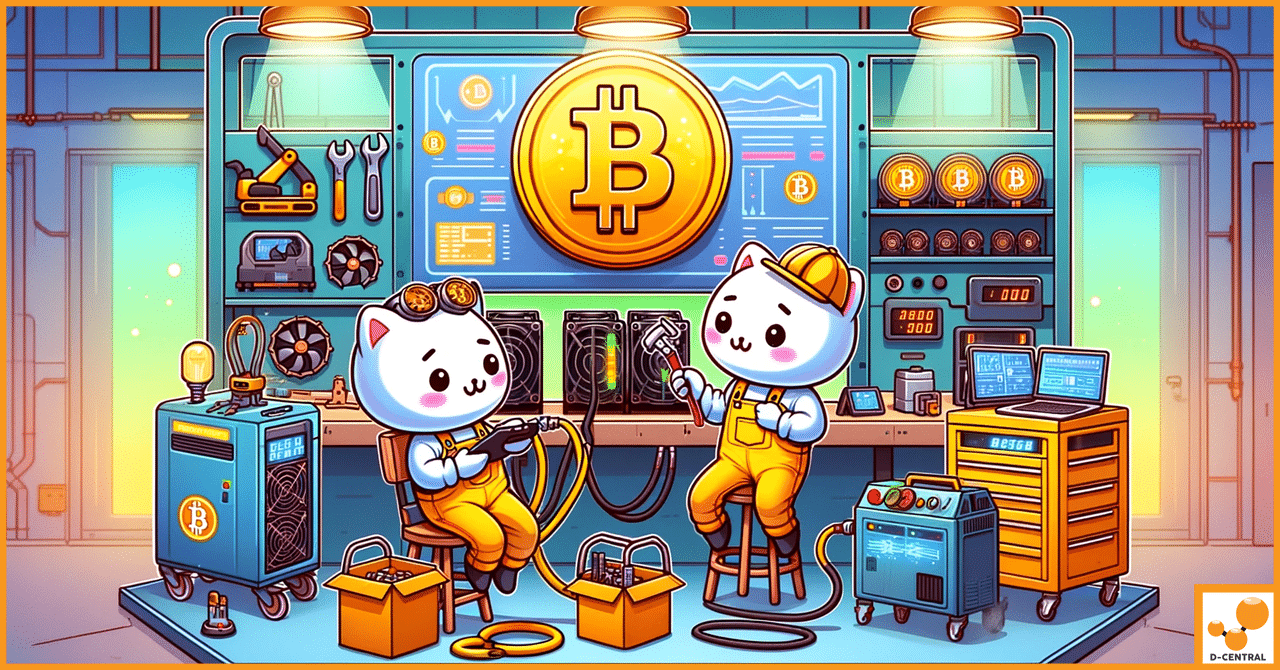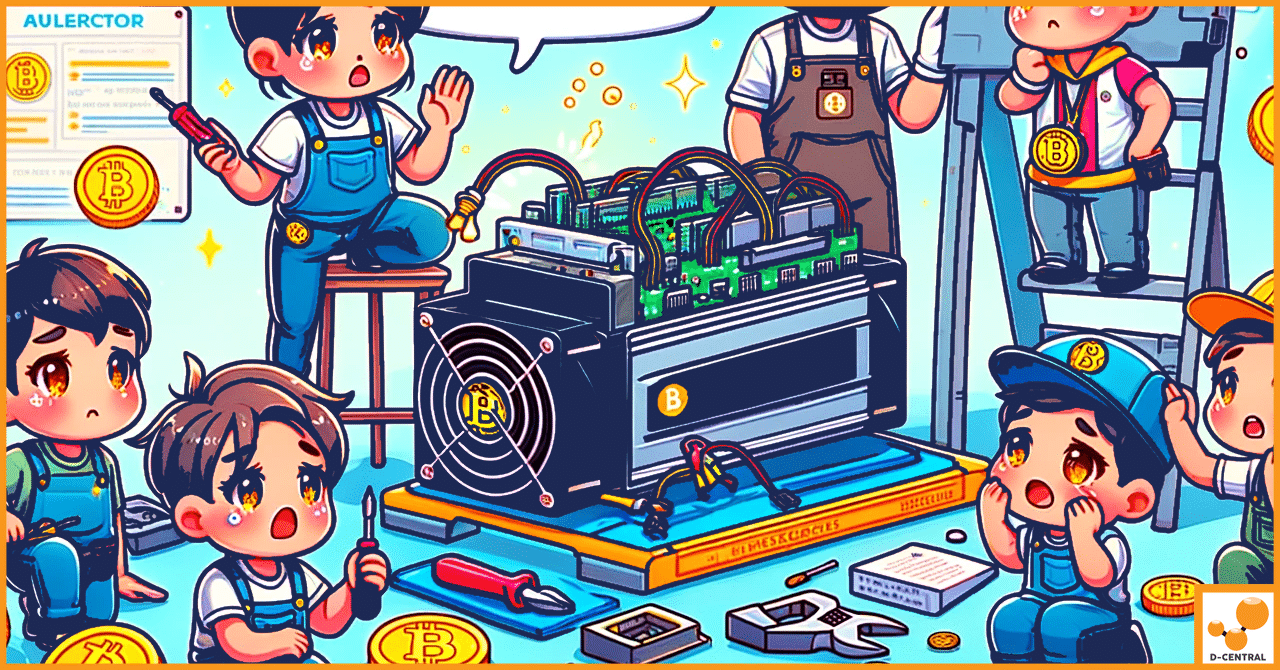
Overcoming Overheating: A Comprehensive Guide to ASIC Repair, Prevention, and Fixes
In the rapidly evolving landscape of the Bitcoin mining industry, Application-Specific Integrated Circuits (ASICs) have emerged as the cornerstone of
4479 Desserte Nord Autoroute 440, Laval, QC H7P 6E2

In the ever-evolving world of cryptocurrency mining, Application-Specific Integrated Circuit (ASIC) miners have emerged as pivotal tools. These specialized devices are engineered to perform the singular task of mining cryptocurrencies such as Bitcoin, Ethereum, and Litecoin, offering unmatched efficiency and speed compared to general-purpose hardware like CPUs and GPUs. The specificity of ASIC miners to their mining tasks not only maximizes the potential for profitability but also significantly contributes to the security and integrity of blockchain networks.
However, as with any sophisticated technology, ASIC miners are not immune to challenges. Common issues range from hardware failures, such as burnt-out chips and malfunctioning fans, to software glitches that can impede their operation. Overheating, power supply problems, and network connectivity issues are also frequent hurdles that can affect an ASIC miner’s performance. These problems can be daunting, leading many to wonder whether their investment might be at risk.
The good news is that a substantial number of these issues can be diagnosed and effectively repaired, restoring your mining operations to their peak performance. Whether it’s through DIY fixes guided by a wealth of available information or by seeking professional repair services, there’s often a solution at hand. In this guide, we will delve into the common problems encountered by ASIC miners, providing you with the knowledge to identify, troubleshoot, and repair your mining hardware. Our goal is to arm you with the confidence and know-how to keep your mining operations running smoothly, ensuring that your venture into the world of cryptocurrency mining remains as profitable and efficient as possible.
Application-Specific Integrated Circuit (ASIC) miners are the gold standard in the realm of cryptocurrency mining. Unlike their predecessors—CPUs, GPUs, and FPGAs—ASIC miners are designed with a singular focus: to mine specific cryptocurrencies at unparalleled speeds and efficiency. This specialization allows ASIC miners to excel at solving the complex cryptographic puzzles required to secure blockchain transactions and, in turn, generate new cryptocurrency as a reward.
ASIC miners have significantly shifted the landscape of cryptocurrency mining, making it more competitive but also more rewarding for those equipped with these powerful machines. Their introduction has led to the development of large-scale mining operations, as the efficiency of ASIC technology makes it possible to mine profitably at a scale and speed that was previously unimaginable. This has not only increased the security of blockchain networks by diversifying and expanding the pool of miners but has also pushed the boundaries of mining technology, leading to constant innovation in the field.
Several ASIC miner models have risen to prominence, each designed for mining specific cryptocurrencies. Among the most renowned models are the Antminer series by Bitmain, the AvalonMiners by Canaan, and the WhatsMiner series by MicroBT. These models are highly sought after for their reliability, efficiency, and the competitive edge they offer in the mining industry.
Despite these challenges, the common issues faced by these ASIC miners are often repairable with the right knowledge and resources. Understanding the specific problems that can arise with your model is the first step toward maintaining and optimizing your mining equipment for long-term success. Regular maintenance, timely firmware updates, and careful monitoring of mining conditions can mitigate many of the common issues, ensuring that your ASIC miner continues to contribute to the cryptocurrency ecosystem efficiently.
Before diving into the specifics of troubleshooting your ASIC miner, it’s crucial to recognize the signs that something might be amiss. Identifying common symptoms early can save you time and prevent minor issues from escalating into major, costly problems. Here are some initial symptoms that indicate your ASIC miner may be malfunctioning:
Once you’ve identified the initial symptoms, the next step is to dive deeper into diagnosing the specific issue with your ASIC miner. Understanding how to interpret error messages, signs of overheating, and performance issues will guide you towards the right solution.
Diagnosing issues with your ASIC miner involves a combination of observing physical signs, interpreting error messages, and monitoring performance data. By systematically checking these areas, you can identify the root cause of the problem and take appropriate action to resolve it, whether that means making adjustments to your setup, performing repairs, or seeking professional assistance.
Navigating the challenges of ASIC mining requires a blend of technical knowledge and practical troubleshooting skills. Here’s a guide to some of the most common problems faced by ASIC miners, along with effective solutions to keep your operations running smoothly.
Causes and Prevention: Overheating can occur due to inadequate cooling, high ambient temperatures, or dust accumulation restricting airflow. Preventing overheating starts with optimal placement in a cool, well-ventilated area, regular cleaning to remove dust, and ensuring that the miner’s cooling system is functioning correctly.
Cooling Solutions: Enhance cooling by using additional fans, upgrading existing cooling systems, or employing liquid cooling solutions for high-performance setups. Monitoring temperatures closely through software can also help you adjust cooling as needed to prevent overheating.
Identifying Power Supply Problems: Signs of power supply issues include frequent shutdowns, failure to start, or erratic miner behavior. Check for visible signs of damage or wear on cables and connectors, and use a multimeter to verify the output voltage of the power supply unit (PSU) matches the specifications.
Repair or Replace?: If a PSU is faulty, repairing it often requires specialized knowledge and tools. For most users, replacing a defective PSU with one that matches the miner’s power requirements and has a good efficiency rating (80 Plus Gold or higher) is the safest and most efficient solution.
Common Hardware Issues: Fans, chips, and power supplies are among the most frequently encountered hardware failures. Symptoms include overheating, decreased hashing performance, or the miner not starting at all.
DIY Repair Tips vs. Professional Repair Services: Replacing fans and cleaning out dust can usually be done at home. More complex issues, like chip or power supply failures, often require professional repair services, especially if reflow soldering or component replacement is needed.
Diagnosing Software Issues: Software errors can manifest as decreased performance, inability to connect to the mining pool, or frequent crashes. Checking log files and error messages can provide clues to the underlying issue.
Updating and Troubleshooting Firmware: Keeping your miner’s firmware up to date is crucial for stability and performance. Download firmware updates only from the manufacturer’s official website and follow their installation guide meticulously to avoid bricking your device.
Network and Mining Pool Connectivity Problems: Connectivity issues can lead to lost mining time and decreased earnings. Symptoms include the miner showing as inactive in the pool dashboard or fluctuating hash rates.
Solutions for Stable Mining Operations: Ensure your network hardware (modems, routers, switches) is reliable and that your internet connection is stable. Use ethernet connections over Wi-Fi for increased stability. Regularly update your mining pool settings and verify that your miner’s network settings are correctly configured.
Impact of Dust, Humidity, and Temperature: Dust can clog cooling systems, humidity can cause corrosion or short circuits, and high temperatures can lead to overheating and hardware damage.
Maintenance Tips for Optimal Performance: Keep your mining environment clean and dust-free using air filters and regular cleaning. Control humidity levels to avoid condensation, and maintain an ambient temperature conducive to efficient miner operation, ideally between 20°C and 30°C (68°F to 86°F).
Addressing these common problems with informed solutions can dramatically improve the performance and longevity of your ASIC miners, ensuring your mining operations remain productive and profitable.
Navigating the decision between undertaking do-it-yourself (DIY) repairs on your ASIC miner and seeking professional assistance is crucial for maintaining the longevity and efficiency of your mining operations. Understanding when each option is appropriate can save you both time and money, ensuring your mining venture remains profitable.
Tools and Knowledge Required: Basic maintenance and some repairs can often be performed at home with a modest set of tools and a good understanding of electronics. Essential tools include screwdrivers, thermal paste for overheating issues, compressed air for dusting, and a multimeter for testing electrical components. Knowledge-wise, familiarize yourself with your miner’s architecture through manuals or online forums. DIY repairs are suitable for issues like replacing faulty fans, cleaning dust-clogged miners, or updating firmware.
Considerations: Attempt DIY repairs only if you’re confident in your understanding of the problem and the repair process. Mistakes can lead to further damage or even void warranties. Always prioritize safety, especially when dealing with electrical components.
Research: Look for services with positive reviews from the mining community. Forums, social media groups dedicated to cryptocurrency mining, and platforms like Reddit can be invaluable resources for finding recommendations.
Certifications and Experience: Opt for repair services that specialize in ASIC miners and have certified technicians with proven experience. Don’t hesitate to ask for references or case studies of their previous work.
Warranty and Cost: Consider repair services that offer a warranty on their repairs. Get an estimate upfront and weigh the cost of repairs against the potential return from your miner’s future performance.
Manufacturer’s Warranty: Before attempting any repairs, check if your miner is still under the manufacturer’s warranty. DIY repairs can void warranties, so it’s often best to contact the manufacturer for repair services if your device is covered.
Professional Diagnostics: Complex issues, especially those related to the miner’s mainboard or power supply unit, might require professional diagnostics to accurately identify. Professional services can provide a detailed analysis of the issue, ensuring that the correct problem is addressed.
Peace of Mind: Professional repair services offer peace of mind that the repair will be done correctly, often backed by a guarantee. This can be particularly important for expensive or hard-to-replace mining hardware.
In conclusion, while DIY repairs can be cost-effective for minor issues, recognizing when professional assistance is needed is crucial for preserving the functionality and efficiency of your ASIC miners. Opting for professional repairs, especially for complex issues, can prevent further damage, uphold manufacturer warranties, and ensure that your mining hardware remains in peak operating condition.
Ensuring the longevity and optimal performance of your ASIC miners involves regular preventive maintenance and care. A systematic approach to maintenance not only prevents downtime but also extends the lifespan of your mining equipment. Here’s a comprehensive guide to keeping your ASIC miners in top condition.
Preventive maintenance is the key to maximizing the efficiency and lifespan of your ASIC miners. By following a routine maintenance checklist and adopting best practices for care, you can ensure that your mining operation continues to thrive. Regular updates to firmware and software further enhance performance, security, and stability, making them an essential component of miner maintenance.
In the fast-paced world of cryptocurrency mining, staying competitive often means keeping your hardware up to date. While regular maintenance can extend the lifespan of your ASIC miners, there comes a time when upgrading becomes necessary for efficiency, profitability, and staying ahead in the mining game. Recognizing the signs that it’s time to upgrade and conducting a cost-benefit analysis of repair versus replacement can help you make informed decisions.
When deciding whether to repair your existing miner or invest in a new model, consider the following factors:
Upgrading your ASIC miner is a decision that should be based on a careful assessment of your current mining operation’s performance, the potential benefits of new technology, and the financial implications of upgrading versus repairing. By staying informed about the latest developments in ASIC technology and conducting a thorough cost-benefit analysis, you can ensure that your mining operation remains profitable and competitive in the ever-changing world of cryptocurrency mining.
Navigating the complexities of ASIC miner maintenance and repair is an essential aspect of running a successful cryptocurrency mining operation. We’ve explored various facets of ASIC miner care, from identifying and diagnosing common issues to undertaking both DIY repairs and seeking professional assistance. Key points emphasize the importance of routine maintenance, the signs indicating it might be time for an upgrade, and the crucial cost-benefit analysis involved in deciding whether to repair or replace your mining hardware.
Ongoing maintenance and a commitment to learning are pivotal in ensuring the longevity and efficiency of your ASIC miners. The landscape of cryptocurrency mining is ever-evolving, with technological advancements and changes in market dynamics constantly presenting new challenges and opportunities. Staying informed and adaptable is crucial.
We encourage our readers to share their experiences with ASIC miner repair and maintenance. Whether it’s a DIY repair hack that saved you time and money or a recommendation for a professional service that helped you get back to mining sooner, your insights could be invaluable to the mining community.
For those seeking further assistance with troubleshooting and repairs, we offer consultation services tailored to your specific needs. Our team of experts can help diagnose issues, recommend solutions, and guide you through the repair process, ensuring your mining operation runs as smoothly and efficiently as possible.
For more resources, guidance, or to get in touch for a consultation, please visit our website or contact us directly. Your success in cryptocurrency mining is our priority, and we’re here to support you every step of the way.
Let’s continue to share knowledge, support each other, and push the boundaries of what’s possible in cryptocurrency mining. Together, we can overcome the challenges and seize the opportunities that lie ahead in this exciting and dynamic field.
What are ASIC miners and why are they important?
ASIC miners, or Application-Specific Integrated Circuits, are specialized devices designed specifically for mining cryptocurrencies like Bitcoin, Ethereum, and Litecoin. They are pivotal for their unmatched efficiency and speed, maximizing profitability and significantly contributing to the security and integrity of blockchain networks.
What common problems do ASIC miners face?
Common issues include hardware failures such as burnt-out chips and malfunctioning fans, software glitches, overheating, power supply problems, and network connectivity issues. These can affect the performance and operational efficiency of ASIC miners.
How can I troubleshoot and repair my ASIC miner?
Issues can often be diagnosed and repaired through DIY fixes with available information online or by seeking professional repair services. Understanding the specific problems your model may face and engaging in routine maintenance can keep your mining operations running smoothly.
What are some signs that my ASIC miner is malfunctioning?
Key symptoms include a noticeable drop in hash rate, an uptick in error rates, unusual noises, excessive heat, and frequent restarts or shutdowns. Identifying these signs early can prevent minor issues from escalating into major problems.
Is it better to repair an ASIC miner myself or seek professional help?
While DIY repairs can address minor issues, recognizing when professional assistance is needed is crucial for maintaining the functionality and efficiency of your ASIC miners. Complex issues often require professional diagnostics and repairs to prevent further damage and uphold warranties.
What maintenance should I perform to ensure my ASIC miner’s longevity?
Routine maintenance includes regular dusting and cleaning, inspecting and replacing malfunctioning components like fans, checking power supplies, monitoring temperature and humidity, updating firmware and software, and securing connections. This systematic approach prevents downtime and extends the lifespan of mining equipment.
When should I consider upgrading my ASIC miner?
Signs it’s time to upgrade include decreased profitability, increased difficulty levels, frequent repairs, and if your miner is several generations behind current technology. Conducting a cost-benefit analysis of repair versus replacement can help make this decision.
Where can I find more assistance with ASIC miner troubleshooting and repairs?
For further assistance, consulting with experts who offer tailored consultation services can be valuable. They can help diagnose issues, recommend solutions, and guide you through the repair process to ensure efficient mining operations.
DISCLAIMER: D-Central Technologies and its associated content, including this blog, do not serve as financial advisors or official investment advisors. The insights and opinions shared here or by any guests featured in our content are provided purely for informational and educational purposes. Such communications should not be interpreted as financial, investment, legal, tax, or any form of specific advice. We are committed to advancing the knowledge and understanding of Bitcoin and its potential impact on society. However, we urge our community to proceed with caution and informed judgment in all related endeavors.
Related Posts

In the rapidly evolving landscape of the Bitcoin mining industry, Application-Specific Integrated Circuits (ASICs) have emerged as the cornerstone of

In the digital realm, Bitcoin has emerged as a revolutionary force that has redefined the concept of currency. Born out

Welcome to the world of home cryptocurrency mining! Whether you’re a curious beginner or a seasoned enthusiast, D-Central Technologies offers